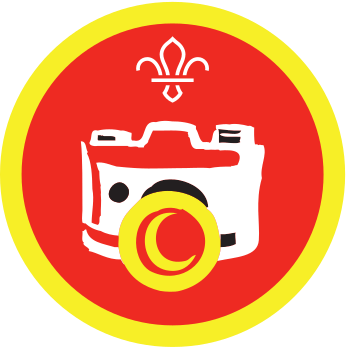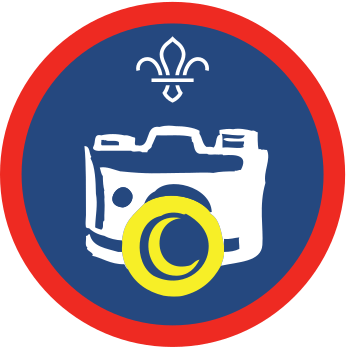Pinhole pictures
You’ll need
- Double sided sticky tape
- Black tape
- An aluminium can
- A needle
- A cork
- Pliers
- Fine sandpaper
- Strips of Velcro
- A dark space to work in
- Photographic paper
- Craft materials (including large scissors, craft knife, glue stick, stiff black card and a metal ruler)
Before you begin
- Have everyone bring to the session their smartphone or a digital camera, if they have one. Each group will need at least one of these.
- Prepare a dark room with a well-lit area. If you’re shooting a landscape outside, go somewhere where there’s shade to take the picture.
- Use the ‘Photographic paper development instructions’ below to prepare the development solution.
Run the activity
- Everyone should get into pairs or small groups. Each group will need a camera template, craft materials and a smartphone or digital camera.
- Groups should use scissors to cut out the template. Glue the cut-out onto the black card, using a glue stick, then cut out the template again. Glue the parts that join together as shown.
- Use the craft knife to score the dotted lines where the template folds. Fold along the dotted lines as shown.
- Cut a hole for the central shutter in the middle of the card. Try to make this as clean as possible, for a smooth shutter action.
- Give out the aluminium cans. Everyone should cut a 3cm x 3cm square from the can with scissors. Give out sandpaper to wear the square clean and flatten it, with care.
- Give out pliers, needles and corks. Clamp the pliers onto the sharp end of the needle and push the eye-end into the cork. Then, holding onto the cork, turn the sharp end of the needle against the centre of the metal square until the needle pierces through. The small hole created is the ‘aperture,’ which lets light enter the camera, like the pupil lets light into your eye.
- Give out the shutter and casing templates. These should be cut out with scissors. Then, the dotted hole in the middle of the shutter-casing template should be cut. Fold the shutter-casing edges inwards. The fold will hold the shutter when it’s moved.
- Give out black tape. Tape the metal plate to the inside of the camera box.
- Now you can glue the edges and stick the camera box together. Give out double-sided sticky tape and use this to attach Velcro to the hinged back of the camera, so that it can be opened or closed. Then glue the cut-out shutter over the pinhole. The shutter should slide in the shutter casing to reveal or hide the pinhole.
- Move the cameras to the dark space. Check that all the joins are well sealed. Open the back of the camera and put some photographic paper inside, with the shutter in the closed position.
- Choose a subject to photograph and place in a well-lit space with nothing else around it. Make sure the camera pinhole is pointed at the subject and is secure, as the exposure time will be relatively long and the camera needs to be still so the picture doesn’t blur. Open the shutter for between 20 and 30 seconds, then close it. The light allowed in should become the image on the photographic paper.
- While everyone’s photos are developed in the solution, check everyone’s understanding of the camera components and the process. See what the groups think would happen to their photos if there was too much or too little light. Ask what difference they think location makes, and how this might affect light exposure.
- Continue to check everyone’s understanding by asking what the groups think about the aperture (the pinhole) and its size. See what they think might happen with a smaller and a larger aperture.
- Everyone should try out their smartphone camera or digital camera. Give everyone some time to familiarise themselves with the device. Then, find out from the groups how the shutter, flash, exposure control and aperture work. See if anyone can change their shutter speed and aperture size. Ask if anyone preferred setting up and using a pinhole camera to the modern alternative.
You will need
- 500ml water
- 10g dried mint leaves, coffee grains or basil (anything with caffeic acid)
- 2g vitamin C tablets
- 10g bicarbonate of soda
- 5ml lemon juice
- A red light such as a bike light
- A dark room that can be lit with the red light
- Coffee filters
- 3 beakers (250ml)
- 3 trays/containers that will fit photographic paper
- Tongs or tweezers to hold the photographic paper
Develop your photos
- Stir 10g of dried mint leaves (or one of the alternatives listed) into a beaker filled with 200ml of hot water. Brew for 15 minutes, then strain through a coffee filter into the second beaker. This will become the developer solution.
- Put two 1g vitamin C tablets into the third beaker, along with 200ml of cold water. Gradually add the 10g bicarbonate of soda and stir to help break down the bubbles.
- Pour both solutions into the first tray, stir and leave for 10 minutes so that the new solution settles. This new solution will be an alkaline developer.
- Make an acidic ‘stop solution’ that will stop the development once the photos look ready. Mix the 5ml of lemon juice directly into a second tray with 200ml of water.
- Put 200ml of water in the third tray. This will be used to rinse the other solutions from the photographic paper.
- In darkness or red light, remove the photographic paper from the camera and put it in the developing solution. Check for an image appearing after 2 minutes.
- When the image has developed enough, remove the photographic paper from the first tray with tongs, and place it in the stop solution for half a minute.
- Remove the paper from the second tray with tongs, then put it in the third tray full of water to rinse.
- You have now developed your paper negative, although it may still darken a little with light exposure. As with all developed negatives, the colours are inverted. It could be displayed as-is for artistic effect; you could also scan the photo and restore the original image by inverting the colours again.
Reflection
Each group made something that would’ve closely resembled the very earliest photographic technology. This means that a similar camera took the first ever photographs. If you were the person to master this new art, what would you take a picture of? What kind of things might be difficult to photograph with the pinhole, and what are its other limitations?
Safety
All activities must be safely managed. You must complete a thorough risk assessment and take appropriate steps to reduce risk. Use the safety checklist to help you plan and risk assess your activity. Always get approval for the activity, and have suitable supervision and an InTouch process.
- Dark
Provide some light, so the environment isn’t completely dark. Everyone must be able to see others and move around the area safely.
- Flammable items
Always take care when using flammable items, especially if you’re near fire. Always follow the manufacturer’s instructions and guidelines.
- Glue and solvents
Always supervise young people appropriately when they’re using glue and solvent products. Make sure there’s plenty of ventilation. Be aware of any medical conditions that could be affected by glue or solvent use and make adjustments as needed.
- Phones and cameras
Make sure parents and carers are aware and have given consent for photography.
- Science
Supervise young people, and only do science activities that are advised and age appropriate for your section. Test activities first, to make sure you’re confident you can lead them safely. Use protective clothing where necessary.
- Scissors
Supervise young people appropriately when they’re using scissors. Store all sharp objects securely, out of the reach of young people.
- Sharp objects
Teach young people how to use sharp objects safely. Supervise them appropriately throughout. Store all sharp objects securely, out of the reach of young people.
Experienced photographers might need to be on hand to help others in their groups, as this activity is difficult. All of the groups will need supervision and help with many of the steps.
Encourage close group work with shared duties and each person working to their strength.
All Scout activities should be inclusive and accessible.
If you choose to present your photos, compare and contrast shots taken with the pinhole camera and the modern alternative. Talk about the use of exposure and aperture size in the photo’s description.
Allow young people to decide between them what subject they’d like to photograph with their cameras.

